Eco-friendly kitchens - 10 ways to be green
When renovating a home, the responsible approach is to include as many green choices as possible.

When renovating a home, the responsible approach is to include as many green choices as possible. From the materials you choose to appliances designed to save power, water and money, there are many ways in which kitchen and appliance manufacturers make their products more eco-friendly. For some, it’s in the production methods – for example, powering their manufacturing plants on timber offcuts, or boosting the efficiency of machines to reduce the carbon footprint. Then there’s the trend towards vintage or antique finds. With so many ways to go green, you’ll be surprised at just how easy creating an eco kitchen is. Here are a few top tips:
Look out for FSC-certified timber. The council’s label helps buyers distinguish wood products, including flooring and furniture, that comes from well-managed forests – the PEFC (Programme for the Endorsement of Forest Certification) has broadly similar promises of sustainability.
There’s no better way to be green than to repurpose something that has already had a good life.There are good reclamation yards and salvage companies across the nation – find one near you at salvo.co.uk, or visit lassco.co.uk.
The eco angle frequently involves using recycled glass. About 400 wine bottles and other glass waste might be involved in the manufacture of worktops or splashbacks for an average-sized kitchen. They are crushed and bound with solvent-free resin before being cast into solid panels and polished. Quartz is another option because it’s plentiful, meaning it has a lower environment impact than buying granite or marble. You might also consider using recycled tiles. Try The Reclaimed Tile Company Reclaimed or recycled wood is another option for worktops. Buy it from a community recycling project and ask a carpenter to turn it into a worktop, unit carcass or doors.
1/10 Use recycled glass and steel
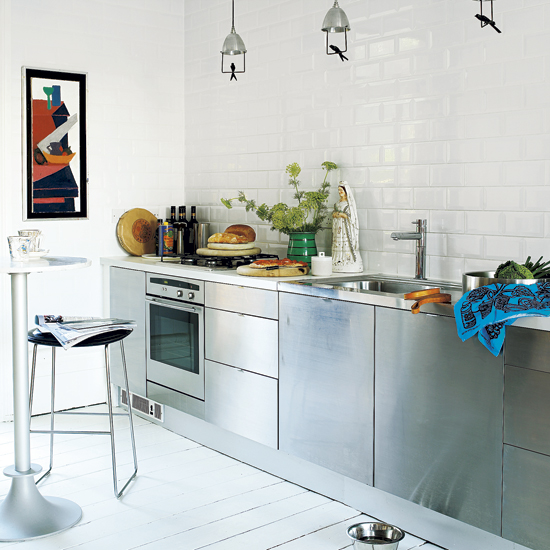
Stainless steel and glass not only look stunning, but also reduce the footprint you leave on the planet. Stainless-steel sinks (above) are generally made from up to 70% recycled material. Recycled glass worktops are hardwearing and have anti-bacterial protection, so are perfect for a busy kitchen.
For more energy saving tips, visit British Gas
2/10 Choose sustainable timber

For a country kitchen that's as eco-friendly as it is stylish, go for units, flooring and worktops made with FSC-certified timber. Another option is to buy boards and parquet planks that have aged gracefully in palaces and country houses in this country and farther afield, from companies like Eco Flooring, Drummonds Flooring and Victorian Woodworks.
Sign up to our newsletter for style inspiration, real homes, project and garden advice and shopping know-how
3/10 Turn off your appliances
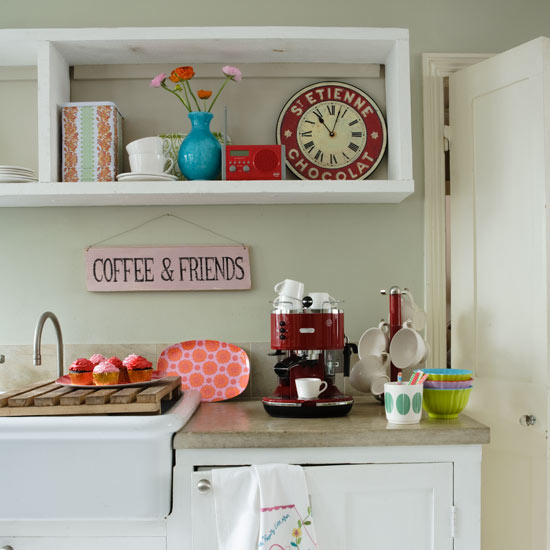
Keeping your kitchen appliances on standby wastes energy. Turn them off manually or get yourself a standby saver that automatically switches off all appliances when they are not in use. Energy ratings now run from A+++ to F, with A+ using the least energy and F using the most. Fridges and freezers must be at least A+. The better the rating, the more energy efficient and, therefore, the most cost effective.
4/10 Recycle
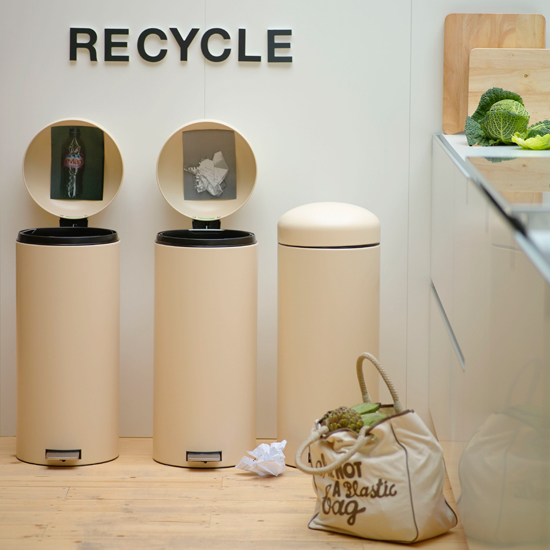
Recycling is key to saving the planet, but it can be a hassle. Make it easier by creating a dedicated recycling area with a range of stylish bins for different types of kitchen waste – have a look at companies such as Hailo and Wesco
5/10 Go for green cleaning
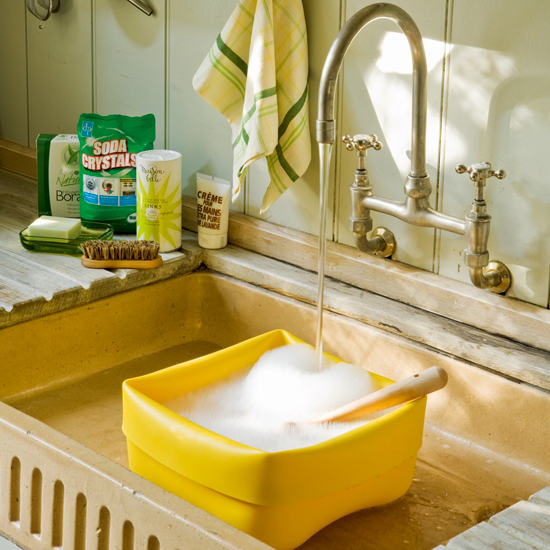
Cleaning products can considerably expand your ecological footprint. Switch to eco-friendly products instead and consider making your own from no-impact kitchen staples, such as vinegar and bicarbonate of soda. Ecover remains a popular choice.
6/10 Try salvage chic
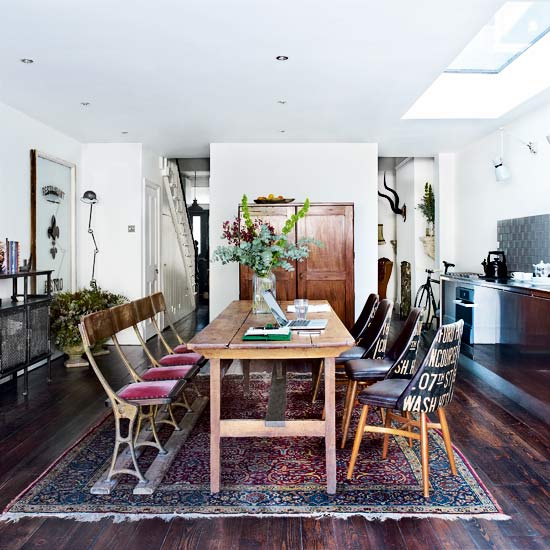
Upcycling furniture and accessories is a great way to add vintage style to your kitchen and reduce your impact on the environment. Use reclaimed materials from salvage yards for flooring and have kitchen cabinets made from reclaimed timber. Look out for characterful plate racks, kitchen dressers, shop fittings that can be transformed into striking islands, old display or sink units, taps and tables. Old science lab worktops are especially popular for the industrial chic look. Often, whole kitchens can be found at sites such as Gumtree, Preloved, Secondhand.org.uk and kitchen specialists like The Used Kitchen Company
7/10 Paint it green
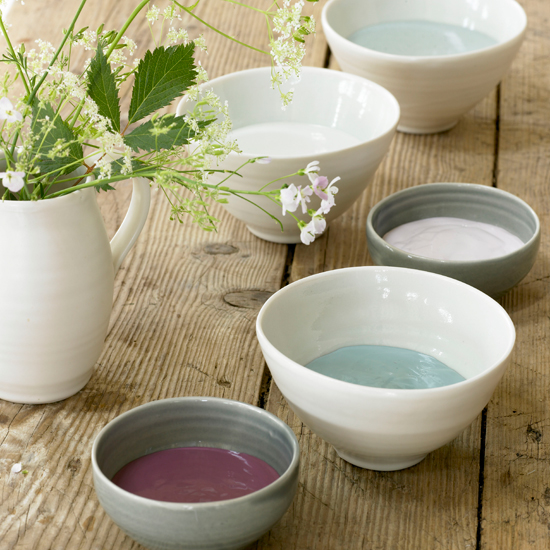
Always choose eco-friendly, water-based kitchen paints made of natural ingredients, with no solvents and little or no VOCs (Volatile Organic Compounds), which are hazardous to both the environment and health. Eco paints are virtually VOC free – using just a little to preserve the paint. Look for Earthborn, Farrow & Ball and Little Greene. Some paints are additionally described as organic – try Ecos and Auro – which means they are also free of pesticides and herbicides.
8/10 Opt for natural, hardwearing floors

Made of linseed oil and pine resin – both sustainable materials – linoleum is warm under your feet and very hardwearing. Other eco-friendly alternatives include cork – have a look at The Cork Flooring Company – which absorbs sound well, and bamboo – try Simply Bamboo and The Bamboo Flooring Company. There is, however, a small question mark over bamboo's eco credentials. Popular as it is, bamboo is starting to be grown at the expense of natural forests. It’s grown mainly in China, so you need to factor in transportation.
9/10 Save water

Kitchen appliances can use up a lot of water. Choose an efficient washing machine to reduce waste and run it on full load for optimum efficiency. As of 2014, washing machines can only be A+++ rated (most energy efficient), A++, A+ or A (least energy efficient). As a guide, Beko estimates its EcoSmart A+++ machine could save £19 every year compared to an older model, enough energy to give you the first 157 washes for free.
10/10 Mind the dishwasher

The latest generation of green dishwashers will consume significantly less energy and water than older models. In fact, some of the best dishwashers use only 6 litres of water per cycle. Washing a full load equivalent by hand can use up to 100 litres. Always run them at full load: the half-load setting uses more than half the energy and water used on a full load. Choose a small model if there aren't many of you in the house. For more energy saving tips, visit British Gas.

Thea Babington-Stitt is the Assistant Editor for Ideal Home. Thea has been working across some of the UK’s leading interiors titles for nearly 10 years.
She started working on these magazines and websites after graduating from City University London with a Masters in Magazine Journalism. Before moving to Ideal Home, Thea was News and Features Editor at Homes & Gardens, LivingEtc and Country Homes & Interiors.